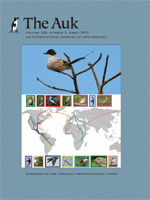Birds are full of surprises. While transmission line corridors can be a blight in many landscapes, in the Northeastern United States they are providing valuable grassland and shrubland habitat for vulnerable bird species.
And how do birds find their way along their migration routes? A study by Cornell Lab of Ornithology and University of Nebraska researchers focused on birds that do a “loop migration,” that is, taking a slightly different route south than north. They found that on the way north, the birds were following the greening of vegetation.
Read the Cornell Lab of O press release announcing the paper here.
Read the abstract in the Proceedings of the Royal Society B here. (Subscription or fee required to read the whole thing.)

 Geolocators are a relatively new tool that allows researchers to track the movements of small animals, such as birds.
Geolocators are a relatively new tool that allows researchers to track the movements of small animals, such as birds.